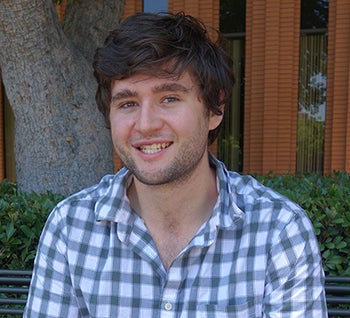Center for Advanced Genocide Research Awards 2017 USC Undergraduate Student Research Fellowship to Griffin Williams
Griffin Williams is challenging assumptions held by some of the most famous names in Holocaust scholarship as a 2017 DEFY Undergraduate Research Fellow at USC Shoah Foundation Center for Advanced Genocide Research this summer.
During his month-long fellowship, Williams, a junior history major at USC, is building on research into prisoner escapes and death marches during the Holocaust that he began in Center director Wolf Gruner’s class last semester. Now, he’s focusing more specifically on death marches – how Nazi officers treated the prisoners on the marches, what caused prisoner casualties and deaths, and how commonly-held narratives about death marches may oversimplify what really happened.
Two of the foremost authorities on death marches are Daniel Blatman (The Death Marches) and Daniel Goldhagen (Hitler’s Willing Executioners), who suggest that death marches were a final act of Nazi cruelty intended to kill the remaining Jews – but Williams said the testimonies in the Visual History Archive offer a more nuanced view of death marches that suggest there was much more variation in how prisoners were treated than either of those scholars acknowledge.
“It depended on the leader who was leading the march. There were varying degrees of cruelty,” Williams said. “A big reason for that is as the war effort collapsed on the Nazi side, there was much less communication with the central regime or any other regimes for that matter.”
Testimonies of death march survivors in the Visual History Archive actually demonstrate that the SS guards who led large groups of prisoners on the marches ranged from brutal to benevolent, Williams has found. Some shot those who fell behind while others let prisoners rest and gave their charges as much food as they could.
Williams has also found that the SS soldiers themselves were wary of being responsible for such large groups of prisoners outside the grounds of concentration camps and were even afraid of leaving bodies behind, lest Soviet troops discover them and punish the SS for their treatment of Jews.
Williams made another discovery in the testimonies: many prisoner deaths during marches at the end of the war were probably a result of the American military’s attacks on German rail lines, barracks and columns of marchers they mistook for soldiers.
The destruction of rail lines meant that emaciated prisoners were forced to walk for weeks straight without rest, often until they died, as their guards pushed them on to other camps. And as dozens of marches converged on German army barracks and other camps close to the front lines, the marchers were easily mistaken for German soldiers, and American planes bombed them mercilessly. Williams found testimonies that describe such a bombing at Allach, a sub-camp of Dachau, the day before it was liberated.
“There’s a scene of carnage that leaves several hundred Jews dead,” he said. “It shows that [Americans] were not careful at all in the way we strafed and bombed and the result was you had huge casualties.”
Past scholars had a tendency to draw sweeping conclusions about the death marches based on limited survivor testimonies and data, which has left our understanding of them limited, Williams said. But with the Visual History Archive and its 55,000 testimonies, he can get a better sense of the wide variety of scenes that actually played out on these marches.
“I think these researchers didn’t have such a tool, they were only able to look at sparing testimonies and had to draw larger conclusions from those testimonies,” Williams said. “Because I have such a larger data set I see a clearer picture.”
Williams intends to turn the research he’s conducted during his DEFY fellowship into his honors thesis, which he hopes will widen our perspective on both German and American behavior during the Holocaust. He’s seen that not all Germans were vicious, and that Americans are not completely without fault.
“We don’t take time to assign any of the blame on ourselves,” Williams said. “You could be hitting the wrong target more often than you think and you have to take responsibility for that.”
